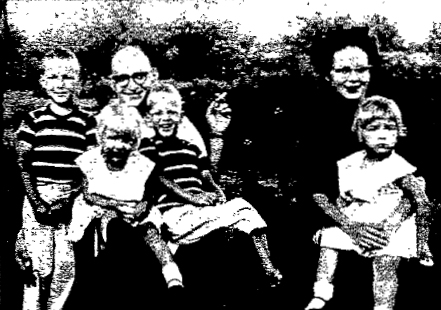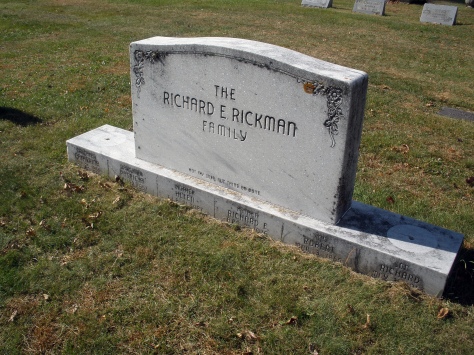As he prepared his six-seat Beechcraft C35 Bonanza airplane for takeoff, Richard E. Rickman asked airport manager John Stedman if he should take the most direct route, across expansive Lake Michigan to Detroit. Stedman cautioned against it, telling the pilot to fly east across Wisconsin to the lake, then hug the shore and make his way over to Michigan. This approach would presumably be safer, and provide great views for Rickman, his wife and four children.
It was just after the dinner hour on Labor Day 1960. The Rickman family packed themselves into the aircraft at Alexander Field in Wisconsin Rapids, ready to make the flight home to Detroit. The family had been to Drummond, Wis., to visit Helen Rickman’s parents, then flew to the Rapids to visit other relatives.
Richard, the son of a longtime shoe-store proprietor, grew up in Wisconsin Rapids. He was a descendant of pioneer resident Matthias Hanneman, who came to Wisconsin in 1866 from Pomerania. A factory representative for the Ogden Manufacturing Co., Rickman married the former Helen Anderson in December 1949 and they later moved to Michigan. Their first child, Richard Edward, was born in Lansing in May 1953. Robert John was born in Lansing in March 1955. Catherine Helen was born in Detroit in June 1956; and Patricia Ann joined the family in Detroit in September 1957.

The final day of the Rickmans’ visit was spent at the airfield. Rickman gave plane rides to his sister, Elvira Pluke, her husband Nolan and their five children. Rickman primarily used the single-engine aircraft for business trips. The family had recently flown to California in the plane, and then used it for the Labor Day weekend visit.
The wheels of the Beechcraft left the ground of Alexander Field at 6:30 p.m. The Rickman family flew along the western shore of Lake Michigan. They were treated to an incredible view of the Chicago skyline as the aircraft flew less an a mile offshore. The first sign of trouble came near 7:30 p.m., when Rickman issued distress calls that were heard by ships and aircraft as far north as Milwaukee. Rickman radioed Meigs Field in downtown Chicago and asked permission to make an emergency landing because the plane’s engine was cutting out.
Officials at Meigs Field gave Rickman permission for an emergency landing. He veered the aircraft out over the lake and circled to attempt a landing. Witnesses at nearby Oak Street Beach saw sparks trailing from the airplane. The 185-horsepower Continental engine caught fire and became enveloped in smoke. Suddenly, the 25-foot-long airplane turned straight down and plunged headlong into the lake. Hundreds of horrified beach-goers saw a blinding explosion as the plane hit the water.

William J. Cempleman saw the fiery crash from aboard the yacht Playtime. “The whole lake looked afire. Flames soared twenty-five to thirty feet,” Cempleman said. “When we got to the scene, a big circle of water was flaming. All we could see was an airplane wheel floating.” As the Playtime circled the crash site, Cempleman saw the charred body of little Catherine Rickman, 4, floating about 15 feet from the flames. Newspapers across America later published a dramatic Associated Press photograph of a police marine officer carrying the lifeless body of Catherine to shore. Resuscitation efforts failed.

Police and Coast Guard vessels searched the waters off Oak Street Beach into the night. Divers used underwater lights to aid in the search, but found no trace of the aircraft or the other members of the Rickman family. Divers resume the search on September 6, but did not locate the wreckage or the other victims until September 7. Diver Jeff Daxe, a commercial pilot, was the first to reach the bodies. The Chicago Daily Tribune reported that one body was found 50 feet from the fuselage, while the other four were inside the wreckage. After the victims were recovered and taken to Burnham Harbor, it was discovered that Richard Rickman’s watch stopped at 7:38 p.m.
The impact sheared off both wings, but only one was found. The engine and propeller were found some distance from the rest of the wreckage in about 30 feet of water. Two weeks after the crash, the Civil Aeronautics Board issued a preliminary opinion that engine failure had caused the crash. In late October the CAB confirmed that opinion, but said the engine would be sent back to the manufacturer for testing. It’s unknown if that ever happened.
The six members of the Rickman family were memorialized at a funeral service on Saturday, September 10, 1960 at Immanuel Lutheran Church in Wisconsin Rapids. They were buried at Forest Hill Cemetery.

Richard Edwin Rickman was born on April 27, 1926, the youngest child of Edwin and Renata (Rathke) Rickman. Edwin John Rickman was the son of Christian Wilhelm Ludwig Theodor and Amelia Bertha Emilie Auguste (Hannemann) Rickman. Amelia’s father was August Friedrich Hanneman, the son of family patriarch Matthias Hannemann. Richard Rickman graduated from Lincoln High School in 1943 and enlisted in the U.S. Navy in July 1943. He served more than three years in the Navy during World War II and was discharged as an ensign in September 1960. He graduated from Northwestern University with a degree in business administration.
©2015 The Hanneman Archive

